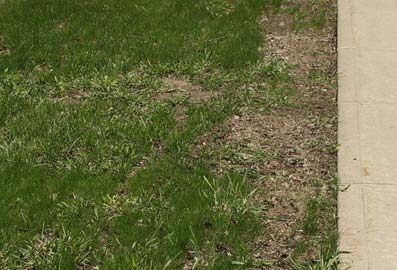By Clark Throssell, Ph.D., turfgrass scientist and LebanonTurf staff member.
 Example of lawn damage along edge of the sidewalk or driveway if deicing salts were heavily used.
Example of lawn damage along edge of the sidewalk or driveway if deicing salts were heavily used.
© Joshua Friell
This winter has been harsher than most across the country and many that don’t typically see ice and snow are feeling the effects of record arctic blasts as far south as Texas, Louisiana and Florida. Consequently, many that don’t usually have to use an ice melt or deicing product on their walkways and driveways may find the need for it this winter. Whether ice melt products are new territory for you or something you use on a regular basis—you’ll want to watch for potential damage to the lawn.
As the snow melts later this winter or spring you may notice a strip of brown grass along the edge of the sidewalk or driveway if deicing salts were heavily used this winter. As the name implies, all deicing salts contain salt. These materials are also often referred to as Ice Melt, Road Salt, Rock Salt, Ice Melter – depending on the brand. The specific kind of salt varies by product. These deicing salts have the potential to damage your lawn if used in large amounts over the winter, especially as snow gets pushed off onto the lawn from the driveway or walkways that are cleared.
Be patient and wait for the grass to green up to determine the extent of the damaged or dead turfgrass. As the grass greens up later this spring it will be obvious how much, if any, grass has died.
In most cases the grass damaged by deicing salts will recover on its own. Melting snow, and rain in the spring, will often flush the accumulated salts from the deicing products from the soil. The flushing of salts will help the grass recover. Recovery may take 6 or 8 weeks or more as the grass fills in the damaged areas. As the temperature warms up, the rate of recovery will increase. In the absence of normal spring rainfall, hand watering the damaged areas three or four times in the spring should help flush the salts from the soil.
If damage is more severe and the lawn has greened-up except for areas near the sidewalks or driveway—it is likely time to reseed these trouble spots. In situations like this where there are several areas of dead grass it makes sense to purchase a product that contains seed, mulch and fertilizer.
Use a heavy rake to remove all the dead grass from the damaged areas. Discard the dead grass. Use the rake or a shovel to loosen the top ¼–½ inch of soil to create a good seed bed. Spread the seed, mulch and fertilizer combination product following label directions and water regularly until the seed has become well established.
It will take two to four weeks for the seed to germinate depending on temperature. The cooler the temperatures, the longer it will take the seed to germinate. And it will take six to eight weeks after the seed germinates for the new seed to become well established.
A couple words of caution if you plan to reseed the damaged areas; first, do not apply a preemergent herbicide over the damaged areas where you plan to reseed. The preemergent herbicide that controls crabgrass seed will also prevent turfgrass seed from germinating. Second, wait until the new grass reaches the height of the existing grass and has been mowed two or three times before applying a herbicide that will control broadleaf weeds.